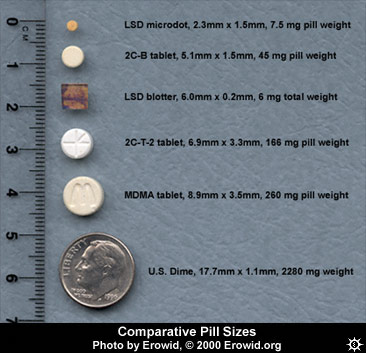Myth Debunking
Mescaline in Microdots
May 2001
Citation: Erowid, Fire. "Myth Debunking: Mescaline in Microdots". Erowid Extracts. May 2001;1:10.
Rumors persist about tiny mescaline containing tablets. Some dealers will actually sell microdots as "mescaline" and it's not difficult to find people who will argue that the effects of these tablets are "definitely different than LSD". While many people know that it's just about impossible that a microdot or tiny pill would contain mescaline, it can be difficult to convince someone who just spent money to purchase the rare substance that they most likely bought LSD instead. In cases like this, references can be useful, and a picture is worth a thousand words.


- A threshold dose of mescaline (the dose at which the smallest amount of recognizable effects can be felt) is somewhere around 100 mg. A normal active dose for most people falls in the 200-400 mg range.1
- An average size MDMA tablet weighs around 250 mg, including all binders and fillers. In general, less than half of this weight is actually MDMA. Likewise there are pressed 2C-B tablets which weigh 45 mg and contain 5 mg of 2C-B, about 1/9 of their weight. A standard microdot weighs only 7.5 mg. Assuming that only 1/3 of this material is binders, that means a maximum of 5 mg of active material in the micro-tablet.
- While there are a few psychoactives which are active in the 5 mg range, mescaline is definitely not one of them. It would be difficult to get a threshold dose of mescaline into a tablet even as large as an ecstasy tablet (similar in size to a standard advil or aspirin tablet). A full dose of mescaline (400 mg) barely fits into a fully packed large capsule with no fillers. At 5 mg of mescaline per microdot, it would take between 50 and 75 tablets to equal a single dose.

